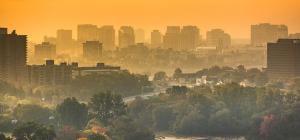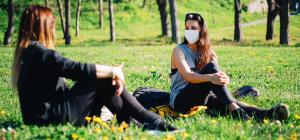
Face shields in public: Better than nothing, but not good enough

Given that close quarters are sometimes unavoidable during the pandemic, the use of equipment to both limit the emission of infectious particles (source control) and avoid contacting other’s particles (personal protection) has become essential. The use of a non-medical or cloth face covering is recommended by the Public Health Agency of Canada (PHAC) whenever people are out of their homes. As per their guidelines, non-medical face coverings should fit securely over the mouth and nose without gaping, while at the same time allowing the wearer to breathe freely. The expectation is that such a face covering will decrease both the particles released and particles inhaled, although not as well as a medical mask.
However, many workplaces and members of the public have opted to use face shields, more typically used in conjunction with a mask, gloves, and gowns in health care settings, instead of a mask-type face covering. There are a number of reasons for this. Masks may cause discomfort, difficulty breathing, skin irritation, and “maskne.” In some users, a mask may trigger bouts of asthma or anxiety, and fogged up glasses impair vision. Masks also hinder interpersonal interaction and non-verbal communication, and can give rise to heightened feelings of loneliness, isolation, and frustration amongst the deaf and hard of hearing.
Face shields, in contrast, reduce touching of the face, are easy to fit, are quick and easy to clean, and are easier to manage for those with cognitive difficulties. Many schools have opted to use face shields to facilitate social and emotional learning in children, who generally have more trouble adapting to mask use. Face shields also block droplet contact with the eyes, now believed to be an important portal of entry for SARS-CoV-2, and can be easily and cheaply obtained. However, shields do not fit tightly to the face, which has raised concern that face shields may not adequately reduce the risk of transmission from droplets or smaller particles. Reliance on face shields alone is suspected to be at the root of a restaurant outbreak in Switzerland.
What is the evidence for face shields as source control or personal protection?
The evidence on whether or not face shields alone are effective against respiratory diseases is sparse, and further complicated by our uncertainty as to the role of aerosols in COVID-19 transmission. A previous rapid review conducted by Public Health Ontario looked at face shields in health care settings and determined that there was insufficient evidence to determine whether face shields can be relied upon for either source control or PPE. More recently, Verma et al. (2020) used two perpendicular laser light sheets to visualize the flow of respiratory droplets in and out of a standard face shield, as well as several other devices (two surgical masks, an N95, and an N95 with an exhalation valve). They found that although the face shield blocked the forward expiratory jet of a simulated sneeze, it did not prevent droplets from diffusing outward from the bottom of the mask and spreading several feet in front of and behind the source over about 10 s. The N95 performed best in terms of blocking escaping droplets, the valved mask released a stream of droplets, and two surgical masks tested varied greatly in their effectiveness, perhaps reflecting differences in the quality of materials used. These results suggest that face shields may be one of the less desirable options for source control. In contrast, in a non-peer-reviewed pre-print, Ronen et al. found that placing a face shield on a cough simulator was as effective as a surgical mask in blocking particles from reaching an unmasked “breathing” mannikin placed 60 cm straight ahead, although they did not measure other points in space around the cough simulator.
To examine the value of masks as personal protection, Ronen et al. 2020 placed a full face shield on a “breathing” mannikin and measured the size and concentration of droplets that were able to reach the mannikin’s airway when exposed to a simulated cough from the front and the sides. Although the simulation found that the face shield was quite effective in blocking droplets and aerosols after being coughed in the face, it provided less protection when the cough originated from the sides or from 30 cm above or below the wearer’s face, depending on the dimensions of the shield. Similarly, Lindsley et al. (2014) found that wearing a face shield blocked 96% of the larger particles that would have otherwise been immediately inhaled. However, the shield was less effective against smaller particles, and grew less effective overall as minutes passed and the remaining smaller particles diffused throughout the space and were drawn behind the shield.
Thus, although face shields seem to provide some benefit in blocking the initial jet of particles expelled during a cough or a sneeze, they may not be a good option for prolonged interactions or when continuously occupying a space where aerosols might be accumulating. In addition, because face shields are less effective at blocking smaller particles, they may be particularly problematic if aerosol transmission is a more important route than currently believed. Because particles were able to flow both into and out of face shields, this research emphasizes the importance of having some sort of filtration apparatus to trap or remove particles, or at minimum to close the gap between the shield and face as much as possible.
What is the role for face shields as a public health tool?
Currently, PHAC has advised that face shields alone do not provide either personal protection or source control, and should only be used if a mask cannot be worn (and then only if they wrap around the face and cover the chin). This is consistent with many other major organizations, including the US CDC the World Health Organization. However, the argument has been made that, despite their lesser effectiveness, recommending face shields over masks would generate a greater overall public health benefit if such an approach led to more people covering their faces in public. This might be the case if masking non-compliance were high. However, a recent internet-based survey of more than 1500 Canadians found that, as of September 2020, support for a universal masking mandate had risen to 83%, 16% higher than previously observed in July 2020. This would suggest that Canadians generally are not averse to masking, and that being so, masking should be urged as the preferred method for both source control and personal protection.
What about when a mask or a face shield just won’t do?
Dissatisfaction with standard medical masks, cloth masks, and/or face shields has led to the development of a number of alternatives. These include both highly improvised DIY masks, as well as products that have undergone a more rigorous development process. The table below demonstrates the variety of approaches taken and identifies some potential advantages and disadvantages with respect to PHAC’s recommendations for face coverings (breathable material, fits without gaping, can be secured to the head, can be easily cleaned, is comfortable and does not require frequently touching the face). For a more comprehensive description of medical masks and non-medical face coverings, please see our NCCEH document Masking during the COVID-19 pandemic.
Examples of modified masks and/or face shields
|
Face Coverings |
Advantages |
Disadvantages |
|
Mini masks that are cut to size from a medical mask and glued over the lips and nose; developed by dermatologists |
Allow work on most of the face during aesthetic or dermatologic procedures |
Decreased surface area for filtration would make breathing more difficult or tear the glue; smaller particles would still be forced through the non-woven material; glue may irritate skin. |
|
Windowed masks made of fabric or a non-woven material that also feature an acrylic panel |
Allow non-verbal communication like lip reading and smiling |
The larger the acrylic window, the lower the surface area of the fabric for filtration, and the more air will be forced out around the edges. |
|
Mouth shields made of transparent plastic that cover only the nose, mouth, and chin
|
Allow non-verbal communication; almost invisible (aesthetic appearance). |
Have no filtration capacity, all air is forced around the edges of the shield; minimal to no protection of the mouth and nose, especially if speaking to a taller person. |
|
Transparent mouth shields that seal to the face and have a filtration apparatus for air flowing in and out |
Allow non-verbal communication; no ear band irritation; minimal air flow around edges |
Expensive and not widely available; skin irritation; filtration capacity and seal need to be tested; not clear how long/whether they remain secure on the face. |
|
Face shields with a drape |
Allow non-verbal communication and free movement of the face, easy breathing; drape intended to capture particles escaping around the edges |
The drape is likely better than nothing, but should not be expected to stop smaller particles from escaping |
|
Cloth choral masks featuring an extra-large cavity in front of the nose and mouth |
Allows free movement of the face and easy breathing, and creation of a resonant sound. |
Must be properly fitted to keep tight to the face; mask may become less effective or hot as the singer’s breathing becomes heavier. |
|
Full head enclosures, e.g., full-face snorkels retrofitted with a filter or made-for-purpose helmets that encase the entire head.
|
Are designed to prevent air from flowing in or out of the head space except through a filtration apparatus |
Experts have comment on negative psychological impacts of this visual on public streets. |
Summary
The importance of covering one’s face is only increasing as we move into our first winter of COVID-19. When selecting a face covering, wearers should refer to PHAC’s guidelines and ensure that their chosen covering meets those criteria. However, choosing the right face covering is based on a number of factors and wearing a PHAC-recommended face covering may not be possible for all people or in all situations. If individuals must rely only on face shields, the limitations of these coverings must be communicated clearly and their activities adjusted accordingly. Finally, it is critical to understand that no face covering is sufficient or adequate protection without other basic tools like hand hygiene, respiratory etiquette, and physical distancing.







